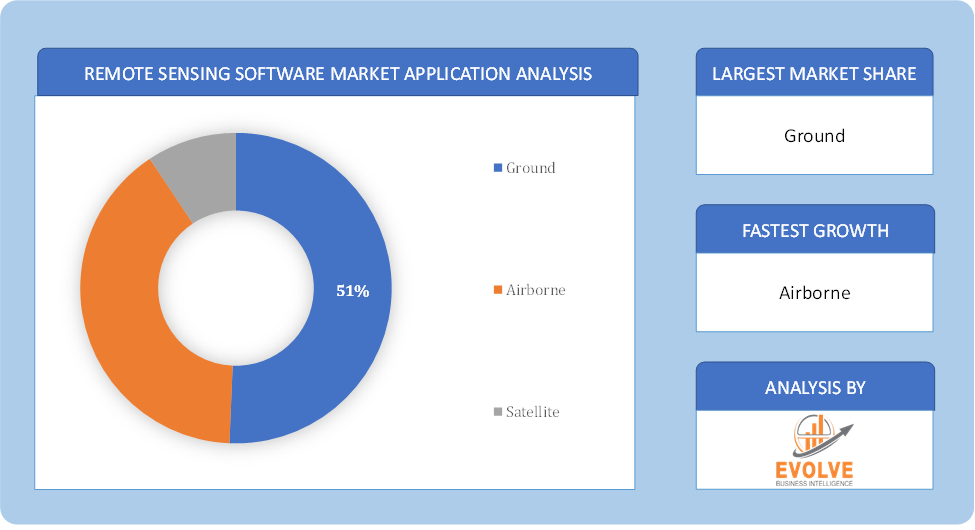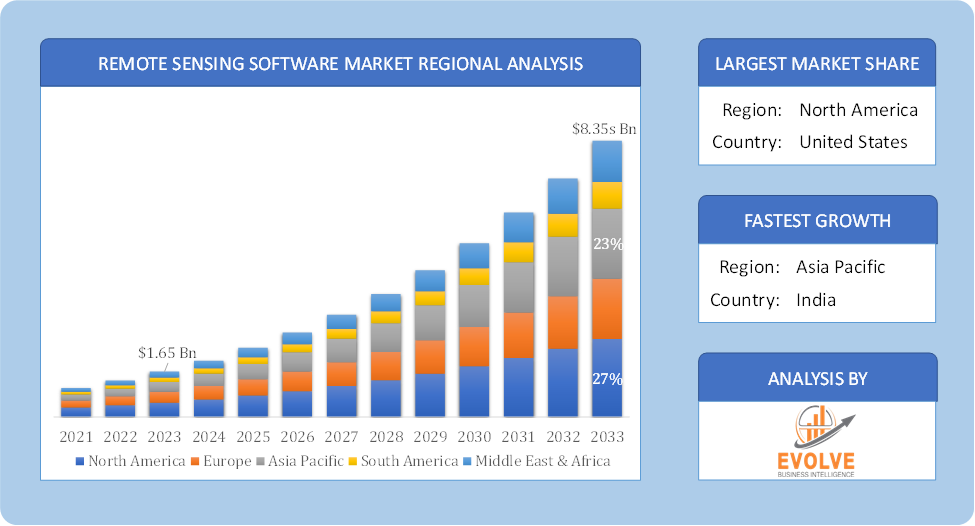Remote Sensing Software Market Overview
The Remote Sensing Software Market Size is expected to reach USD 8.35 Billion by 2033. The Remote Sensing Software Market industry size accounted for USD 1.65 Billion in 2023 and is expected to expand at a compound annual growth rate (CAGR) of 13.42% from 2023 to 2033. The Remote Sensing Software Market refers to the industry segment focused on the development, distribution, and application of software tools that facilitate the processing, analysis, and interpretation of data captured through remote sensing technologies. Remote sensing involves the collection of information about an object or area from a distance, typically using satellite, aerial, or drone-based sensors. This software is essential for managing and analyzing vast amounts of data collected from these sensors, which can include imagery, environmental data, and other spatial information.
The growth of the Remote Sensing Software Market is driven by the rising demand for accurate geospatial information, advancements in sensor technologies, and the increasing adoption of remote sensing across various sectors for data-driven decision-making.
Global Remote Sensing Software Market Synopsis
The COVID-19 pandemic had a significant impact on the Remote Sensing Software Market. The pandemic caused disruptions in the global supply chain, affecting the production and delivery of hardware components necessary for remote sensing systems, which in turn impacted the software market. Delays in satellite launches and other remote sensing infrastructure projects slowed the adoption of new software solutions. The need for remote monitoring and analysis became more critical during the pandemic, as organizations sought ways to maintain operations and manage resources without physical presence. Remote sensing software played a key role in monitoring environmental changes, tracking the spread of the virus, and supporting disaster management efforts. Remote sensing software was utilized to monitor environmental changes related to the pandemic, such as reduced pollution levels and changes in land use. The pandemic accelerated the digital transformation of many industries, leading to increased adoption of cloud-based remote sensing software solutions. The shift to remote work and the need for remote collaboration tools drove demand for cloud-based geospatial analysis and data sharing platforms.
Remote Sensing Software Market Dynamics
The major factors that have impacted the growth of Remote Sensing Software Market are as follows:
Drivers:
Ø Technological Advancements
Advances in satellite, aerial, and drone-based sensors have led to higher resolution and more accurate data collection, driving the need for sophisticated software to process and analyze this data. The integration of AI and ML algorithms into remote sensing software has enhanced capabilities for automated data analysis, pattern recognition, and predictive modeling, making the software more powerful and efficient. The rise of cloud computing has made remote sensing software more accessible, scalable, and cost-effective, allowing organizations of all sizes to utilize advanced geospatial analysis tools. The ability to handle and analyze large volumes of geospatial data is a significant driver, as organizations seek to derive actionable insights from the vast amounts of data collected through remote sensing.
Restraint:
- Perception of High Costs of Implementation and Data Privacy
The initial investment required for setting up remote sensing infrastructure, including sensors, satellites, and specialized software, can be prohibitively expensive for small and medium-sized enterprises (SMEs) and developing regions. Maintaining and updating remote sensing systems and software can also be costly, further limiting adoption, especially among organizations with limited budgets. Remote sensing often involves collecting and processing large amounts of geospatial data, which can include sensitive information about land use, infrastructure, and natural resources. Ensuring data privacy and security is a major concern, particularly in sectors like defense and national security.
Opportunity:
⮚ Growth of Cloud-Based Solutions
The shift towards cloud-based remote sensing software solutions offers scalability, ease of access, and cost efficiency, making advanced geospatial analysis tools available to a wider range of users, including SMEs and researchers. Cloud platforms facilitate real-time collaboration and data sharing among teams, enhancing the ability to conduct joint research, environmental monitoring, and disaster management across different geographies. The development of smart cities presents an opportunity for remote sensing software to be integrated into urban planning, traffic management, and environmental monitoring systems, leveraging IoT networks for real-time data collection and analysis.
Remote Sensing Software Market Segment Overview
Based on Application, the market is segmented based on Ground, Airborne and Satellite. The Satellite segment dominant the market. Satellite remote sensing involves the use of satellites equipped with sensors to capture data from space. This segment provides extensive coverage and is crucial for global monitoring and large-scale applications. Satellites can cover vast and remote areas, providing data on a global scale. By End Component
Based on Component, the market segment has been divided into Software and Service. The Software segment dominant the market. The software segment includes the various tools, applications, and platforms used to process, analyze, and visualize remote sensing data. This can range from basic image processing software to advanced analytical tools that integrate AI and machine learning.
By Vehicle Type
Based on Vehicle Type, the market segment has been divided into Government & Defense and Commercial. The Commercial segment dominant the market. The commercial segment covers the use of remote sensing software by private companies across various industries, including agriculture, mining, real estate, and insurance. The focus here is on enhancing business operations, optimizing resource management, and driving innovation.
Global Remote Sensing Software Market Regional Analysis
Based on region, the global Remote Sensing Software Market has been divided into North America, Europe, Asia-Pacific, the Middle East & Africa, and Latin America. North America is projected to dominate the use of the Remote Sensing Software Market followed by the Asia-Pacific and Europe regions.
 Remote Sensing Software North America Market
Remote Sensing Software North America Market
North America holds a dominant position in the Remote Sensing Software Market. In North America, particularly the United States, is a leading market for remote sensing software, driven by strong demand in sectors like defense, agriculture, environmental monitoring, and disaster management and the region benefits from advanced technological infrastructure, high R&D investment, and the presence of major players in the remote sensing software industry.
Remote Sensing Software Asia-Pacific Market
The Asia-Pacific region has indeed emerged as the fastest-growing market for the Remote Sensing Software Market industry. The Asia-Pacific region is experiencing rapid growth in the remote sensing software market, driven by increasing investments in infrastructure, agriculture modernization, and urbanization. Countries like China, India, and Japan are leading in the adoption of remote sensing technologies, with government initiatives focused on smart cities, disaster management, and environmental monitoring and the region’s strong agricultural base creates significant demand for remote sensing software in precision farming, crop monitoring, and resource management.
Competitive Landscape
The global Remote Sensing Software Market is highly competitive, with numerous players offering a wide range of software solutions. The competitive landscape is characterized by the presence of established companies, as well as emerging startups and niche players. To increase their market position and attract a wide consumer base, the businesses are employing various strategies, such as product launches, and strategic alliances.
Prominent Players:
- BAE Systems
- Clark Labs
- Earth Observing System
- ESRI
- Harris Geospatial Solutions Inc.
- Hexagon AB
- MERRICK & COMPANY
- PCI Geomatics
- Textron Systems
- Trimble Inc.
Key Development
In January 2022, Northrop Grumman Corporation successfully conducted a rocket motor static test for its precision strike missile. The purpose of the test was to verify the design of the motor for production. Northrop Grumman’s use of digital technologies helps to make the production of tactical solid rocket motors more cost-effective and efficient.
Scope of the Report
Global Remote Sensing Software Market, by Application
- Ground
- Airborne
- Satellite
Global Remote Sensing Software Market, by Component
- Software
- Service
Global Remote Sensing Software Market, by Vehicle Type
- Government & Defense
Global Remote Sensing Software Market, by Region
- North America
- US
- Canada
- Mexico
- Europe
- UK
- Germany
- France
- Italy
- Spain
- Benelux
- Nordic
- Rest of Europe
- Asia Pacific
- China
- Japan
- South Korea
- Indonesia
- Austalia
- Malaysia
- India
- Rest of Asia Pacific
- South America
- Brazil
- Argentina
- Rest of South America
- Middle East & Africa
- Saudi Arabia
- UAE
- Egypt
- South Africa
- Rest of Middle East & Africa
| Parameters | Indicators |
|---|---|
| Market Size | 2033: USD 8.35 Billion |
| CAGR (2023-2033) | 13.42% |
| Base year | 2022 |
| Forecast Period | 2023-2033 |
| Historical Data | 2021 (2017 to 2020 On Demand) |
| Report Coverage | Revenue Forecast, Competitive Landscape, Growth Factors, and Trends |
| Key Segmentations | Application, Component, Vehicle Type. |
| Geographies Covered | North America, Europe, Asia-Pacific, South America, Middle East, Africa |
| Key Vendors | BAE Systems, Clark Labs, Earth Observing System, ESRI, Harris Geospatial Solutions, Inc., Hexagon AB, MERRICK & COMPANY, PCI Geomatics, Textron Systems and Trimble Inc. |
| Key Market Opportunities | · Growth of Cloud-Based Solutions · Expansion of Smart Cities and IoT Integration |
| Key Market Drivers | · Technological Advancements · Growth of Cloud Computing and Big Data |
REPORT CONTENT BRIEF:
- High-level analysis of the current and future Remote Sensing Software Market trends and opportunities
- Detailed analysis of current market drivers, restraining factors, and opportunities in the future
- Remote Sensing Software Market historical market size for the year 2021, and forecast from 2023 to 2033
- Remote Sensing Software Market share analysis at each product level
- Competitor analysis with detailed insight into its product segment, Government & Defense strength, and strategies adopted.
- Identifies key strategies adopted including product launches and developments, mergers and acquisitions, joint ventures, collaborations, and partnerships as well as funding taken and investment done, among others.
- To identify and understand the various factors involved in the global Remote Sensing Software Market affected by the pandemic
- To provide a detailed insight into the major companies operating in the market. The profiling will include the Government & Defense health of the company’s past 2-3 years with segmental and regional revenue breakup, product offering, recent developments, SWOT analysis, and key strategies.








